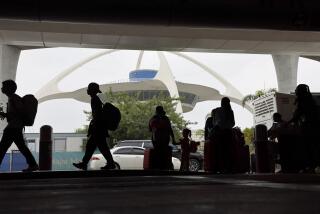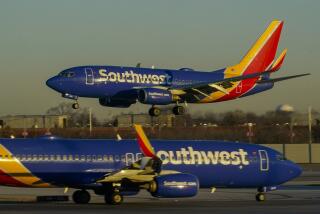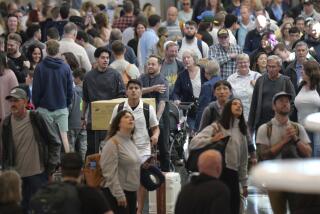Bush seeks to head off air travel chaos
WASHINGTON — To try to ease what he called an “epidemic of aviation delays,” President Bush on Thursday announced a series of new measures -- including a temporary Thanksgiving “express lane” for commercial airplanes in military airspace -- to head off what many feared could be the worst holiday travel season ever.
Saying that Thanksgiving was becoming “a season of dread for too many Americans,” Bush said his administration would take immediate steps to boost airport capacity and alleviate East Coast congestion, which administration officials described as a “choke point” that affects air travel all the way to the West Coast.
The airline industry’s on-time performance this year has been its worst on record. Airlines have scheduled more flights to larger airports, creating congestion in key corridors. And in the aftermath of the Sept. 11 terrorist attacks, the industry slashed its workforce, which meant fewer workers to handle disruptions and fewer crews to fly planes.
Bush’s plan comes as the country faces what may be its busiest Thanksgiving travel season ever, and federal officials said the smallest disruptions or instance of bad weather risked locking up travel across the country.
“Airports are very crowded, travelers are being stranded and flights are delayed, sometimes with a full load of passengers sitting on the runway for hours,” the president said in televised remarks from White House’s Roosevelt Room. These problems “carry some real costs for the country, not just in the inconvenience they cause, but in the business they obstruct and family gatherings they cause people to miss,” he said.
Among other steps, the administration wants to discourage airlines from overbooking by doubling the compensation they must pay to passengers who are involuntarily bumped and cannot be placed on another flight within a certain period of time. Under proposed rules, which had been previously announced, passengers bumped and delayed by two hours or less would be paid $400; those bumped and delayed more than two hours would be paid $800.
If approved, the rules would take effect next summer.
Flight delays erupted into a major political issue when a Valentine’s Day ice storm hit New York’s John F. Kennedy airport. The storm stranded thousands of JetBlue passengers, some for almost 10 hours as their plane sat on the tarmac. Over the next several days the airline canceled hundreds of flights.
Transportation Secretary Mary E. Peters said Thursday that three-quarters of delays are on flights that begin, end or pass through the New York metropolitan region.
But she said that West Coast passengers would also see benefits from fewer delays in cross-country flights.
“Just as some urban areas open up the shoulders of their highway to ease rush-hour commutes, opening these holiday rush lanes in the sky will give pilots additional options for flying around bad weather and speed traffic from New York airports,” Peters said.
This is the first time the government has opened a military flight path from Maine to Florida before an expected air-travel crisis. In the past, the military has permitted civilian planes to use its airspace above 24,000 feet in case of storms or other emergencies.
“To pre-negotiate this in advance of the holiday period is what’s new this time and will allow us to schedule operations on those flight lanes,” Peters said.
The Air Force said the ceded airspace is reserved for training, and few, if any, training missions take place over Thanksgiving. “Our military operations will not be affected,” said Maj. Monica Bland, an Air Force spokeswoman.
There are roughly a dozen north-south air corridors along the Eastern Seaboard, aviation officials said, and use of the military airspace would effectively add two more.
Peters has also asked airports and airlines around the country to increase the amount of equipment, such as baggage carts, available during the holiday period and to bring on additional staff, such as baggage handlers.
To improve air traffic control, the Federal Aviation Administration has canceled all nonessential maintenance and construction to add controllers during the holiday period.
“We’re staffing up, making sure that we have everything in place to prevent delays to the greatest extent we can,” Peters said.
The administration is also considering a plan to charge airlines higher fees for scheduling flights at popular travel times. The approach, known as “congestion pricing,” is designed to give airlines and passengers an incentive to travel at off-peak times.
The airlines “will pass some costs on, but the fact is, customers are paying the price today with lack of reliability, lack of predictability, lack of knowing if they can get there on time,” Peters said. “As we open up additional capacity through congestion pricing, price will even off, we’ll see a leveling, so we don’t see a long-term increase in prices.”
Over a 12-day period encompassing Thanksgiving, about 27 million passengers -- an increase of 4% over last year -- are expected to fly on domestic carriers in U.S. airspace.
A repeat of the problems experienced earlier this year could be the “straw that breaks the camel’s back,” said Chris McGinnis, editor of Expedia Travel Trendwatch. Airlines are “fearful that people will stop traveling if they have another debacle,” he said.
In congressional testimony Thursday, Delta Air Lines chief executive Richard Anderson said congestion pricing would threaten the carrier’s “continuing recovery” from bankruptcy.
Anderson also defended overbooking as a strategy to deal with the problem of no-show passengers.
Each flight, he said, has an overbooking level based on its historical no-show rate.
No-shows mean “the airplane’s going to fly with an empty seat -- and at $90 oil or at $70 oil, we can’t afford the business to have people not show up,” Anderson said, noting the high per-barrel cost of fuel. “So we overbook.”
Anderson said airlines reduce overbooking during the holidays because passengers are less likely then to miss their flights.
Some of the measures the administration announced had been in the works for months. Among them are new procedures at JFK and Newark, N.J., airports that would increase their capacity. For instance, federal officials now permit two planes to land on parallel runways at JFK even when they are relying on instruments during storms.
According to the U.S. Department of Transportation, more than 28% of flights arrived late in the first seven months of the year -- the worst performance since comparable data began being collected in 1995. At the same time, 54,000 flights affecting nearly 3.7 million passengers experienced tarmac delays -- an increase of about 42% from the previous year. Overbooking has also gotten worse, despite public anger over the practice.
In the first nine months of this year, airlines bumped passengers at a rate of 1.21 per 10,000, up from 1.04 for January-September 2006.
Federal officials have said that the FAA is overburdened and its equipment outdated, compounding the problems. In his remarks, Bush complained that lawmakers had failed to act on legislation he sent to Congress last winter to help the FAA modernize by training new controllers and moving to a GPS tracking system. “If we really want to solve this problem, it’s time for Congress to modernize the FAA, and we’ve given them a blueprint to do so,” Bush said.
But members of Congress accused Bush of cutting funds for the FAA.
“The president is threatening to veto the transportation appropriations bill that makes investments to build airport capacity at the same time that he is voicing concern about delays,” said Sen. Patty Murray (D-Wash.), who heads a subcommittee on aviation. “Travelers will have President Bush to thank as they wait at the gate and on the runway this holiday weekend.”
Passengers at Orange County’s John Wayne Airport expressed frustration Thursday with the state of air travel. One couple flying in from Columbus, Ohio, for a vacation in Palm Springs said they were skeptical that the initiative would help alleviate the pain of flying.
Dave McCurdy said his initial flight to Palm Springs was canceled the night before. So they flew to Orange County, where they planned to rent a car to drive to Palm Springs.
“It sounds more symbolic,” McCurdy said of the White House plans. “I don’t think it’s going to help.”
Another passenger, Steve Schultheis of Laguna Hills, accused Bush of trying to win public relations points. “Doesn’t he have more important things to worry about, like Iraq and the deficit?” Schultheis said. “He’s got his own FAA staff that should be dealing with this.”
Schultheis, an executive with a company that makes scientific instruments, said the solution to the delays was simple.
“Don’t fly through New York,” he said, recalling how he and his wife got stuck at the airport for several hours last year on their way to Rome.
“We just vowed never to fly through there. If that is the reaction of most people, it would take care of the problem.”
--
peter.pae@latimes.com
Reynolds reported from Washington and Pae from Los Angeles. Times staff writers Julian E. Barnes and Theo Milonopoulos contributed to this report.
--
(BEGIN TEXT OF INFOBOX)
Preventing delays
Highlights of President Bush’s proposals to alleviate air travel delays:
* Make military airspace over the East Coast available for civilian airliners this Thanksgiving season.
* Have the Federal Aviation Administration focus on keeping flights on time, working specifically with the Port Authority of New York and New Jersey to reduce air travel bottlenecks in the New York metropolitan area.
* Encourage airlines to make more staff available to expedite check-in and boarding, set aside extra seats and planes, and bring in additional ticket kiosks and baggage-handling gear.
* Double the amount of compensation that passengers receive when they’re forced off overbooked flights. Implement market-based incentives such as congestion pricing, implementing higher fees at peak hours and at the most crowded airports.
* Encourage use of the Internet to provide real-time updates on flight delays, specifically the website www.fly.faa.gov.
Source: White House
More to Read
Get the L.A. Times Politics newsletter
Deeply reported insights into legislation, politics and policy from Sacramento, Washington and beyond. In your inbox three times per week.
You may occasionally receive promotional content from the Los Angeles Times.










